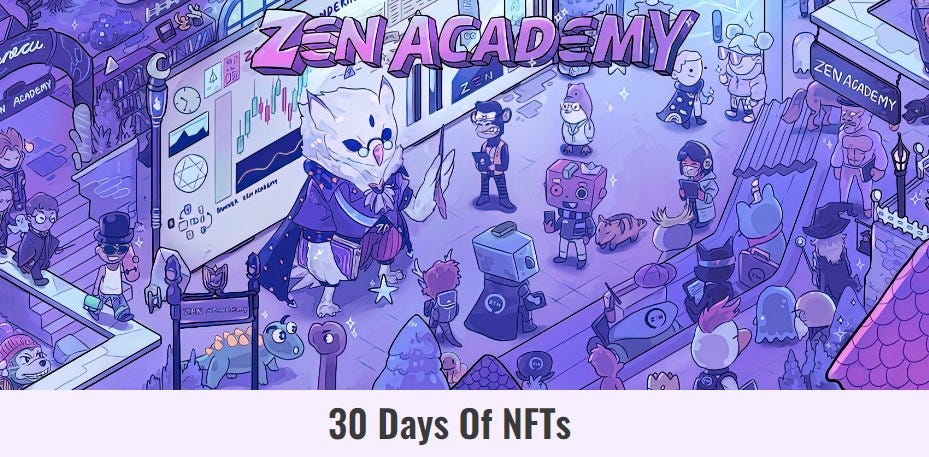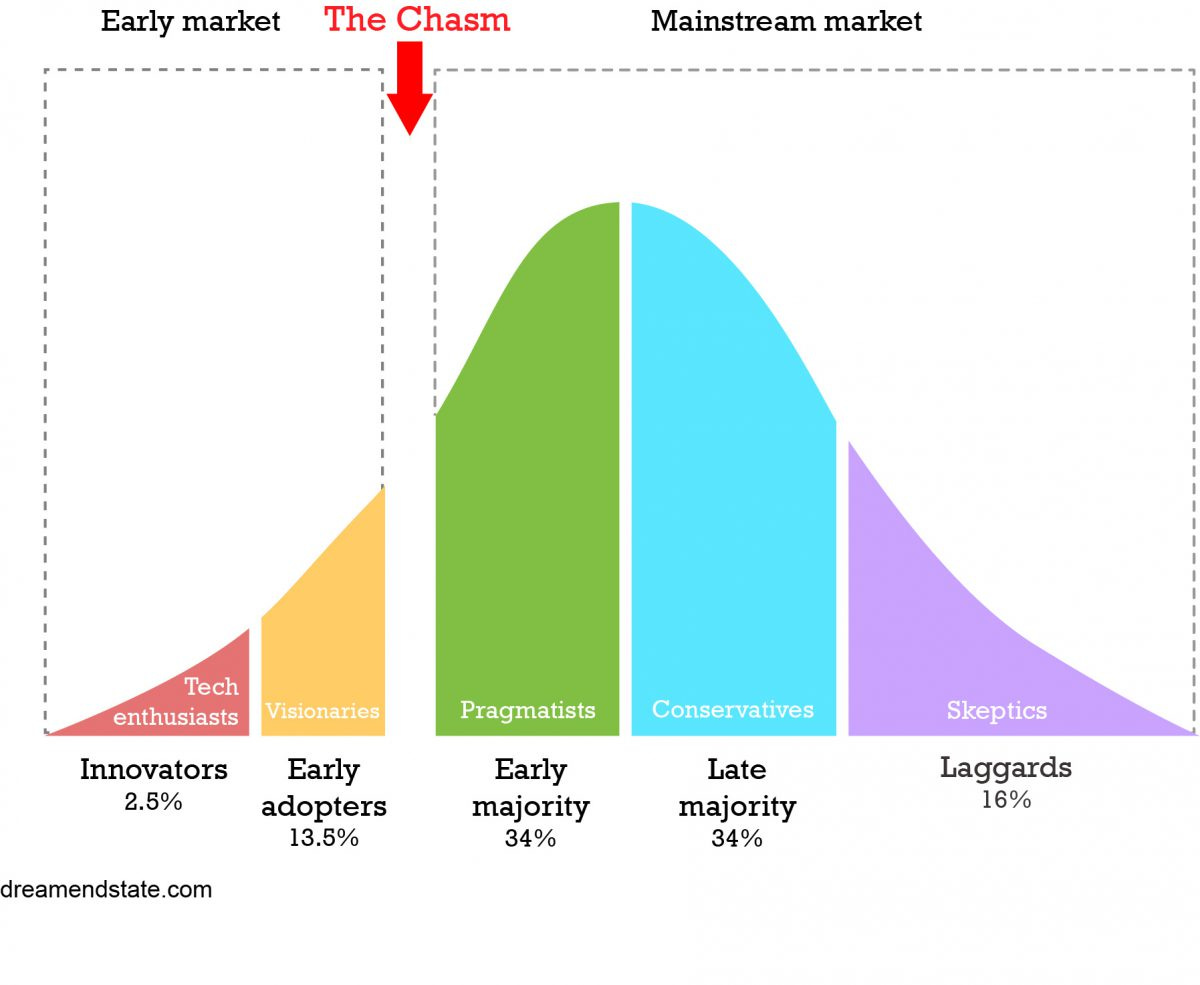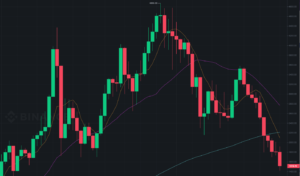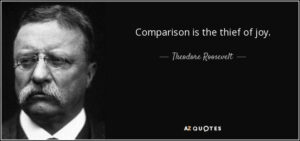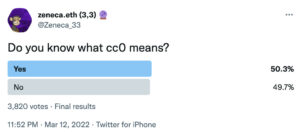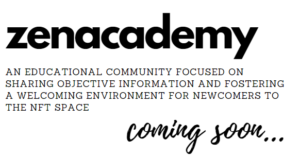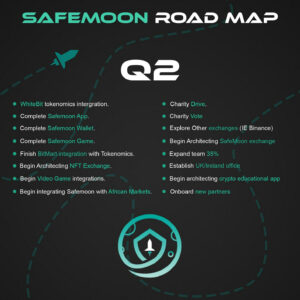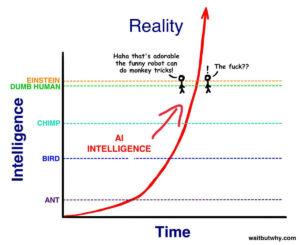Education + Infrastructure + Mentality
I just got back from a week in Vegas for W3BX Expo. I was on stage 11 times for panels, workshops, and talks. I met hundreds of people, including several dozen who were completely green to the world of web3 and NFTs. It was eye opening. The recurring theme in my mind was “how can we improve the new user experience?”
Many of us talk a lot about “going mainstream”. How do we go mainstream, how do we onboard the “normies” (not my favourite word, it’s a bit demeaning). How do we get from where we are to where we want to be?
There are 3 key areas we need to focus on to reach mass adoption (excluding time).
Education + Infrastructure + A Mentality & Perception Shift.
Let’s break them down.
Education
This one is obvious. The learning curve for crypto is steep and treacherous. It is overwhelming for a newcomer. Most people do not have a background in technology or cryptography. Trying to explain what a blockchain is and how it works was always going to be a bit tricky.
After learning about Blockchains, there are about 80 bazillion different directions someone could take on their learning journey. A different Blockchain? Layer 2s? DeFi? Liquidity Pools? PoW vs PoS? ERC20, ERC1155, ERC721, ERC721A? NFTs? DAOs? Metamask, Opensea, Uniswap, Sushiswap, Pancakeswap, LooksRare, x2y2, Blur, Foundation, SuperRare, Art Blocks, Generative Art, zK Rollups, sharding, the merge verge splurge purge surge.
The urge is real, the urge to throw up your hands and say “this shit is too complicated”.
Even in the 18 months or so that I have been full-time in this space, we have improved leaps and bounds on the education front. And compared to 2017 when I first started buying ETH, we are light years ahead. I can’t even imagine what it was like in 2013 or 2010.
Better does not mean good though. We still have a long way to go.
Almost every NFT project should have an education component. Regardless of whether it’s a PFP project, a membership club, or is doing something with gaming, music, art, whatever.
If you’re only trying to capture the attention of those in the space, you’re severely kneecapping your growth potential. Moreover, I believe projects in the space today have a responsibility to help onboard anyone out there curious about this technology.
If we give someone a bad impression of NFTs, they’ll often give up and leave the space for a few years. They’ll complain to their partner, their friends, their hairdresser, and anyone that will listen about how terrible NFTs are.
If, on the other hand, we welcome them and hold their hand through the learning process, they’re far more likely to be a productive member of the community. They’re also more likely to add value to the space (and the world at large). They’re far more likely to take the time to continue to learn and understand the technology.
They’ll now be an ambassador and advocate for the tech to their partner, friends, hairdresser, and anyone that will listen.
Not that we need people out there spreading the good word. We’re not a cult (contrary to popular belief). NFTs are a technology. Blockchain is technology. It is inevitable. In 10 years, everyone is going to be interacting with Blockchain technology, whether they know it or not.
The end state is a matter of when, not if. And therein lies the point.
We can impact the road from here to there. We can make it faster, and smoother. The more people that understand the potential at hand and how it will improve the world, the better. Only then do we stand a chance to have regulators pass reasonable laws. The alternative is having them overreach and over regulate the space and set us back a decade.
Education is key.
At ZenAcademy we recently launched a FREE 30 day beginner course for anyone wishing to learn about NFTs. You can sign up at 30daysofNFTs.com. This is a perfect resource to send to your friends and family members that are NFT-curious.
Infrastructure
This is the one that I am least well equipped to handle, but is arguably the most important. To cut to the chase, we need far better UX/UI. Most of the people who were early to this technology were engineers and coders, not designers or user journey experts. They’ve done a phenomenal job of innovating and laying the groundwork for the future. But there’s a lot to be desired on the usability side of things.
We’re once again miles ahead of where we were in 2021, 2017, and 2010, and are way better than we used to be at all of this — but better does not mean good.
It is still confusing and convoluted to interact with the Blockchain. You’re signing transactions with all sorts of jumbled strings of letters and numbers. If you make a mistake, you lose everything. There are no takesies backsies. No forgot password button. No ability to call the bank and have them reverse your transactions. Insurance isn’t a thing. It’s a cut throat, wild west, winner take all, dog eat dog world. Code is law, and 99.999999% of humans do not understand the code.
Over the course of the next few decades we’ll go through a generational mentality shift. Self custodying assets will be normal. Everyone will understand how powerful it can be to not have to rely on a central bank or an centralized entity. It is going to take decades though. The test to think about is the mum test. Once your mum, or parent, etc, can truly use blockchain technology effortlessly, then we’ve made it.
The same way almost anyone of any age or level of technical knowledge can pull out an iPhone and access the internet and app store and interact with mobile technology, cloud computing, email, and everything else — we will eventually get to a point when Blockchains are straightforward for anyone to interact with as that. They probably won’t even know they’re interacting with one.
Until then, though.. it’s gonna be a slow march forward. We’ve got the innovators, and most of us are the early adopters.
We will cross the chasm, but it is going to take a few years.
And it will take significant infrastructure improvements to get us there.
A Mentality + Perception Shift
This might be the least spoken about one, but not for lack of importance. Most of us in this space need to step out of our bubble and echo chambers and put ourselves in the shoes of someone on the outside looking in.
There’s a reason our reputation isn’t great to the rest of the world. A lot of it is straight up ignorance and people not taking the time to understand the technology, for sure. A lot if it though is also people receiving a terrible first impression because of our actions and/or words.
My favourite example is gaming. A lot of people into NFTs are baffled about why gamers hate NFTs. Surely they should love them. They’re already spending so much money on games and skins and in-game items and currency. Why shouldn’t they have true ownership over these things so they can sell them? (I’m guilty of thinking this way in the past)
Serious gamers might even be able to earn an income from playing games. Sounds amazing. Play to earn, play and earn, play and own. What’s wrong with those stupid gamers, they’re wrong, we’re right, we’ll show them!! One day they’ll see the light.
We’ll show them.
Hold up. Maybe people play games because they want to have fun? Maybe they play games to escape the real world. Maybe they play games to de-stress. Once you add money, finances, and ownership into the equation, all of a sudden there’s a new layer of complexity and stress. Now instead of playing for fun, they’re playing to maximize profit. The goal posts have shifted, and I don’t think in a good way.
Well what about just purely owning the assets you buy — no ability to earn them in game. That’s better, right? Yes and no. It’s great to have the freedom to sell them but it once again adds stress and complexity and thought and responsibility to an area that many are using for entertainment and to relax.
Let’s say you buy a Fortnite skin for $20 today and can use it in game and that’s it. You can’t sell it, even if you quit the game. That’s simple. You pay for something, you use it, and move on.
Now how about if that thing is an NFT and you can sell it when you’re done. On the surface it sounds great, but.. what if after you buy it, you notice the price of it actually goes up a little. Should you sell? Maybe, but you bought it because you loved it, so you’re gonna hold on to it for a little while. The next day you log in and the price is down 50%, oh no! What a disaster, why didn’t you sell yesterday?? Argh. See how easily stress is introduced into what is otherwise a fun pursuit?
I’m not saying that NFTs + Gaming is a bad combination. I personally think it’s a match made in heaven. It will eventually make the entire gaming ecosystem more sustainable and better for the end user. It will bring power and ownership back into the hands of the gamers and away from the “evil overlords” that have been bleeding the industry dry for years now. But we’re a long way from there.
Sustainable tokenomics are absurdly difficult to create.
Not every game should be tokenized.
Most games probably shouldn’t be.
It’s no wonder gamers are (largely) anti-NFT. The way to ‘convince’ them is not to tell them how much money they could make gaming. That might be the literal worst approach. The way is to present a comprehensive perspective, showing both the risks as well as the benefits, and to give them time and space to research on their own.
We also need gaming projects to figure out a way to keep gaming fun and have tokens add to the experience in a way that doesn’t introduce stress. I wish them luck, it’s not an easy problem to solve.
This section got longer than intended as I immediately dovetailed into gaming NFTs. The above example is but one way we’re often presenting a tone deaf experience to those outside our bubble. There are many, many more.
Talking about the money people can make in this space is the right approach for some; it’s the wrong approach for many. The reality is that most people are going to lose money trying to trade crypto / NFTs. The reality is most people are risk averse and don’t want to even try.
The most sound strategy for the most people is probably to DCA (dollar cost average) into BTC + ETH. Adding a few more coins as they get more comfortable. Buy and hold and don’t even attempt to swing trade.
That’s not fun and sexy though and that’s not what gets millions of views on YouTube, TikTok, or Instagram. Nobody is going on The Tonight Show with Jimmy Fallon and talking about how they’ve got 1.5% of their net worth in ETH. The headlines are all the crazy ape sales, the scams, and Elon Musk.
Next time you talk to someone about crypto and/or NFTs, consider your audience. If it’s someone who is risk averse, try not to talk about financial gains and losses. I understand the technology is inexorably linked to finances (it’s right there in the name: cryptocurrency). But that doesn’t mean you have to lead with it. You can talk about ownership and custody and control and self sovereignty. You can talk about tickets as NFTs and the stubs as POAPs. You can talk about simplifying processes, eliminating middlemen, and making our lives more efficient.
For those a little more accepting of risk, and/or with a bit more tech savviness, then by all means, red-pill the hell out of them.
But don’t underestimate the power of Trojan horsing either. The way to persuade is to be empathetic to the other person’s views; not to try and project your views onto them.
🔮 I’m launching a PFP Project
Why? Because I believe I am in a unique position to create something special.
My mission is simple: to find good people who desire to be part of a global community that truly cares about them. We’ve got an incredible base already with ZenAcademy, and I am looking for a few more people to join us. I’m practicing what I preach (see my other Newsletter on doing the unscalable) and intend to have 1:1 calls with hundreds of people and onboard them personally.
If you might be interested in joining, feel free to book a time slot using this calendly link. This is first come first serve, but there will be many more opportunities.
Don’t worry if you are anon, or shy, or don’t speak English — there will be plenty of other, different avenues to join too. We want this to be a global, inclusive project, and we intend to work with communities from all around the world. On that note, if you are a community leader from a community where English isn’t the main language, please reach out to me at pfp@zenacademy.com. I’d love to bridge some gaps.
Stay tuned for more.
Thanks for reading — don’t forget to share 30daysofNFTs.com with your NFT-curious family and friends 💜
Disclaimer: The content covered in this newsletter is not to be considered as investment advice. I’m not a financial adviser. These are only my own opinions and ideas. You should always consult with a professional/licensed financial adviser before trading or investing in any cryptocurrency related product.
- SEO Powered Content & PR Distribution. Get Amplified Today.
- PlatoAiStream. Web3 Data Intelligence. Knowledge Amplified. Access Here.
- Minting the Future w Adryenn Ashley. Access Here.
- Buy and Sell Shares in PRE-IPO Companies with PREIPO®. Access Here.
- Source: https://zeneca33.substack.com/p/how-we-onboard-billions-to-web3
- :is
- :not
- :where
- $UP
- 1
- 10
- 11
- 14
- 15%
- 20
- 200
- 2017
- 2021
- 24
- 30
- 7
- 72
- 9
- a
- ability
- Able
- About
- About Crypto
- above
- access
- actions
- actually
- add
- adding
- Adds
- adopters
- Adoption
- advice
- advocate
- After
- again
- age
- ahead
- All
- already
- also
- alternative
- always
- am
- amazing
- Ambassador
- an
- and
- any
- anyone
- APE
- app
- app store
- approach
- ARE
- AREA
- areas
- around
- Art
- Art Blocks
- AS
- Assets
- At
- attention
- audience
- auto
- average
- away
- back
- background
- Bad
- Bank
- base
- BE
- because
- been
- before
- Beginner
- belief
- believe
- benefits
- Better
- billions
- Bit
- Bleeding
- blockchain
- blockchain technology
- blockchains
- Blocks
- blur
- body
- book
- both
- bought
- Break
- BRIDGE
- bring
- BTC
- bubble
- but
- button
- buy
- Buying
- by
- call
- Calls
- CAN
- capture
- central
- Central Bank
- centralized
- Chance
- chase
- chasm
- Cloud
- cloud computing
- club
- code
- Coins
- COM
- combination
- come
- comfortable
- Communities
- community
- compared
- completely
- complexity
- component
- comprehensive
- computing
- confusing
- Consider
- considered
- content
- continue
- contrary
- control
- Cost
- could
- course
- covered
- crazy
- create
- Cross
- crypto
- cryptocurrency
- cryptography
- cult
- curious
- Currency
- curve
- Custody
- Cut
- DAOs
- day
- Dca
- decade
- decades
- DeFi
- designers
- desired
- different
- difficult
- directions
- disaster
- do
- does
- Doesn’t
- Dog
- doing
- Dollar
- Dollar Cost Average
- don
- done
- Dont
- down
- dozen
- dream
- dry
- Early
- early adopters
- earn
- easily
- easy
- eat
- echo
- ecosystem
- Education
- efficient
- either
- eliminating
- Elon
- Elon Musk
- end
- Engineers
- English
- Entertainment
- Entire
- entity
- equipped
- ERC20
- ERC721
- escape
- etc
- ETH
- Ether (ETH)
- Even
- eventually
- Every
- everyone
- everything
- example
- excluding
- experience
- experts
- Explain
- Expo
- eye
- family
- family members
- far
- faster
- feel
- few
- Figure
- Finances
- financial
- Find
- First
- Focus
- For
- Fortnite
- Forward
- Foundation
- Free
- Freedom
- friends
- from
- front
- fun
- future
- Gains
- game
- Gamers
- Games
- gaming
- Gaming NFTs
- generational
- generative
- get
- Give
- Global
- Go
- goal
- Goes
- going
- good
- great
- Green
- groundwork
- Growth
- growth potential
- guilty
- hand
- handle
- Hands
- Have
- having
- Headlines
- help
- here
- hold
- How
- http
- HTTPS
- Humans
- Hundreds
- i
- ideas
- if
- Ignorance
- image
- imagine
- immediately
- Impact
- importance
- important
- improve
- improved
- improvements
- in
- in-game
- Including
- Inclusive
- Income
- incredible
- industry
- inevitable
- Infrastructure
- innovating
- innovators
- instead
- insurance
- intend
- interact
- interacting
- interested
- Internet
- into
- introduce
- introduced
- investing
- investment
- iPhone
- IT
- items
- Job
- join
- Join us
- joining
- journey
- just
- Keep
- Key
- Key Areas
- Know
- knowledge
- Lack
- language
- large
- largely
- launched
- launching
- Law
- Laws
- layer
- Layer 2s
- lead
- leader
- leaps
- LEARN
- learning
- least
- Leave
- letter
- Level
- lies
- light
- like
- likely
- linked
- Liquidity
- liquidity pools
- little
- Lives
- ll
- log
- Long
- longer
- looking
- LooksRare
- lose
- losses
- Lot
- love
- loved
- luck
- made
- Main
- Mainstream
- make
- Making
- many
- March
- Mass
- Mass Adoption
- Match
- Matter
- Maximize
- mean
- means
- member
- Members
- membership
- Merge
- MetaMask
- middlemen
- might
- millions
- millions of views
- mind
- Mission
- mistake
- Mobile
- Mobile technology
- money
- months
- more
- more efficient
- Moreover
- most
- move
- much
- mum
- Music
- Musk
- name
- Need
- net
- New
- New Tech
- Newsletter
- next
- NFT
- NFT Project
- NFTs
- no
- normal
- Notice..
- now
- numbers
- obvious
- of
- often
- on
- Onboard
- once
- ONE
- only
- opening
- OpenSea
- Opinions
- opportunities
- or
- Other
- otherwise
- our
- out
- outside
- over
- overreach
- own
- ownership
- PancakeSwap
- panels
- part
- partner
- pass
- Password
- past
- Pay
- People
- perception
- perfect
- Personally
- perspective
- pfp project
- phenomenal
- plato
- Plato AiStream
- Plato Data Intelligence
- PlatoAiCast
- PlatoData
- Play
- play to earn
- playing
- please
- Plenty
- Point
- Pools
- Popular
- PoS
- position
- Posts
- potential
- PoW
- power
- powerful
- present
- price
- probably
- Problem
- process
- processes
- Product
- productive
- Profit
- project
- projects
- purely
- put
- RE
- reach
- Reading
- real
- real world
- Reality
- reason
- reasonable
- receiving
- recently
- recurring
- Regardless
- Regulate
- Regulators
- related
- Relax
- rely
- reputation
- research
- resource
- responsibility
- REST
- reverse
- Risk
- risks
- road
- Rollups
- round
- s
- sales
- same
- say
- saying
- scams
- Section
- see
- SELF
- sell
- send
- serve
- set
- several
- severely
- sharding
- Share
- shift
- shifted
- should
- show
- side
- sign
- significant
- signing
- Simple
- simplifying
- Skin
- slow
- smoother
- So
- SOLVE
- some
- Someone
- something
- Sound
- sovereignty
- Space
- speak
- special
- Spending
- Spreading
- Stage
- stand
- started
- State
- Step
- Still
- store
- straight
- straightforward
- Strategy
- stress
- sudden
- SuperRare
- surely
- Surface
- surge
- sushiswap
- sustainable
- Swing
- Take
- taking
- Talk
- talking
- Talks
- tech
- Technical
- Technology
- tell
- test
- than
- that
- The
- The Future
- The Merge
- the world
- their
- Them
- theme
- then
- There.
- therein
- These
- they
- thing
- things
- think
- Thinking
- this
- those
- though?
- thought
- Through
- tickets
- tiktok
- time
- times
- to
- today
- tokenized
- tokenomics
- Tokens
- TONE
- too
- trade
- Trading
- Transactions
- Trojan
- true
- understand
- unique
- Uniswap
- us
- usability
- use
- used
- User
- User Experience
- user journey
- using
- value
- Ve
- VEGAS
- verge
- views
- vs
- want
- was
- Way..
- we
- Web3
- week
- welcome
- WELL
- were
- West
- What
- What is
- when
- whether
- while
- WHO
- why
- Wild
- wild west
- will
- winner
- wishing
- with
- Word
- words
- Work
- works
- Workshops
- world
- worry
- Worst
- worth
- Wrong
- x2y2
- years
- you
- Your
- youtube
- ZK

